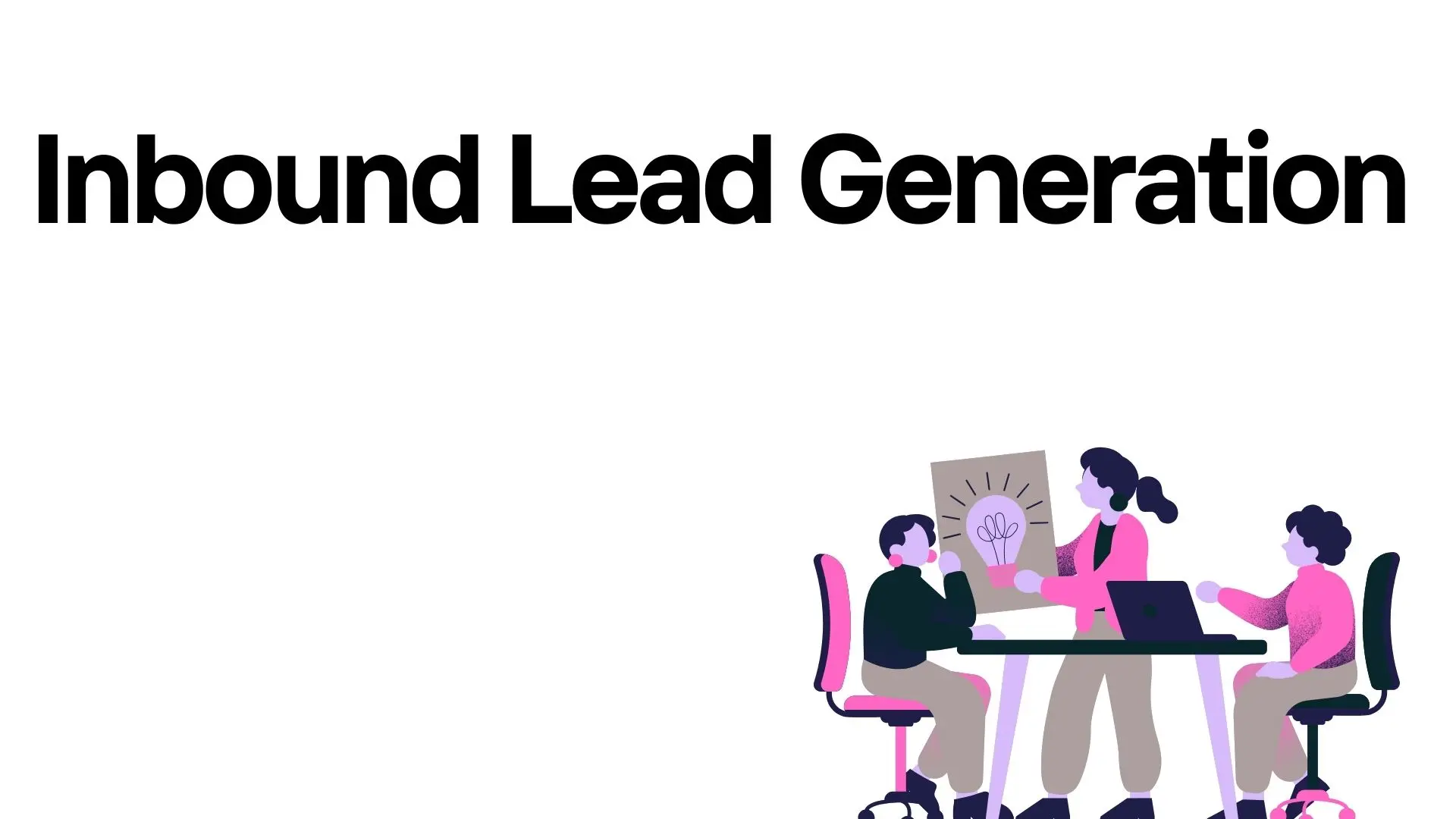Let's face it - the days of lone-wolf selling are over. Today's complex B2B deals require a coordinated team effort, and the numbers don't lie.
According to Gartner, by 2026, sales organizations leveraging effective team selling will outperform their competition by more than 50%.
But here's the thing - while everyone talks about team selling, few organizations actually get it right.
Let’s dive into team selling and explore the new playbook for modern sales success.
What is Team Selling?
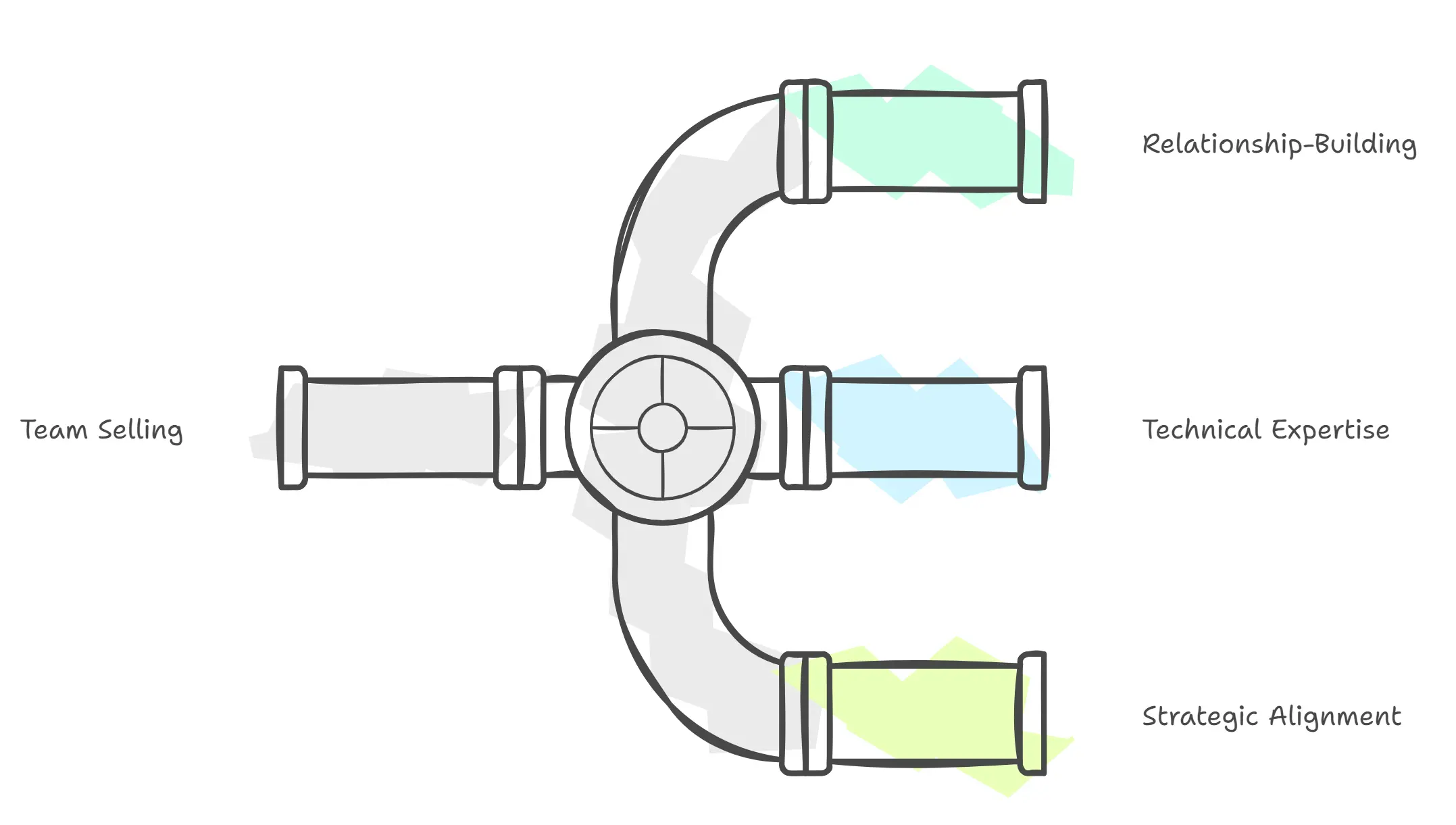
Team selling is all about collaboration. Instead of one salesperson tackling everything solo, multiple team members work together to connect with prospects and guide them through the sales process.
Think of it as a group effort—your sales rep might focus on relationship-building, while your product expert dives into the technical details and your manager ensures strategic alignment.
This tag-team approach isn’t just about closing deals; it’s key for pipeline generation too.
By pooling expertise and engaging prospects from different angles, team selling helps you build a stronger, more reliable pipeline packed with opportunities.
It’s like bringing the whole squad to the game—everyone plays their role, and you’re set up to win.
Team Selling Strategy in a Nutshell
Team selling is about bringing the right people together to tackle the complexities of modern sales.
It’s a collaborative, well-coordinated approach that lets your team shine in their individual strengths while driving better results together.
Here’s how it works in practice:
Start with a Warm Introduction
.webp)
First impressions matter, and starting with a warm introduction can set the stage for success.
Whether it’s reaching out through a mutual contact, leveraging a referral, or building rapport through shared interests or experiences, this simple step can make your prospect feel more at ease.
A warm introduction creates a positive tone right from the start, making your outreach feel less transactional and more genuine.
It opens the door for authentic, two-way conversations and lays the foundation for trust, which is critical in any selling process.
Leverage Executive Outreach
Big partnerships often require interaction at the highest levels, and that’s where executive outreach becomes essential.
When senior leadership from your team connects with decision-makers on the client side, it demonstrates commitment and professionalism.
This adds weight to your proposal, showing the client that you’re taking their needs seriously and are prepared to treat them as true partners, not just customers.
Executive outreach can also help uncover the broader strategic goals of the client’s business, aligning your pitch to deliver more impactful solutions.
It’s not just about closing the deal—it’s about establishing credibility and trust at the top.
Build a Pipeline Generation Plan
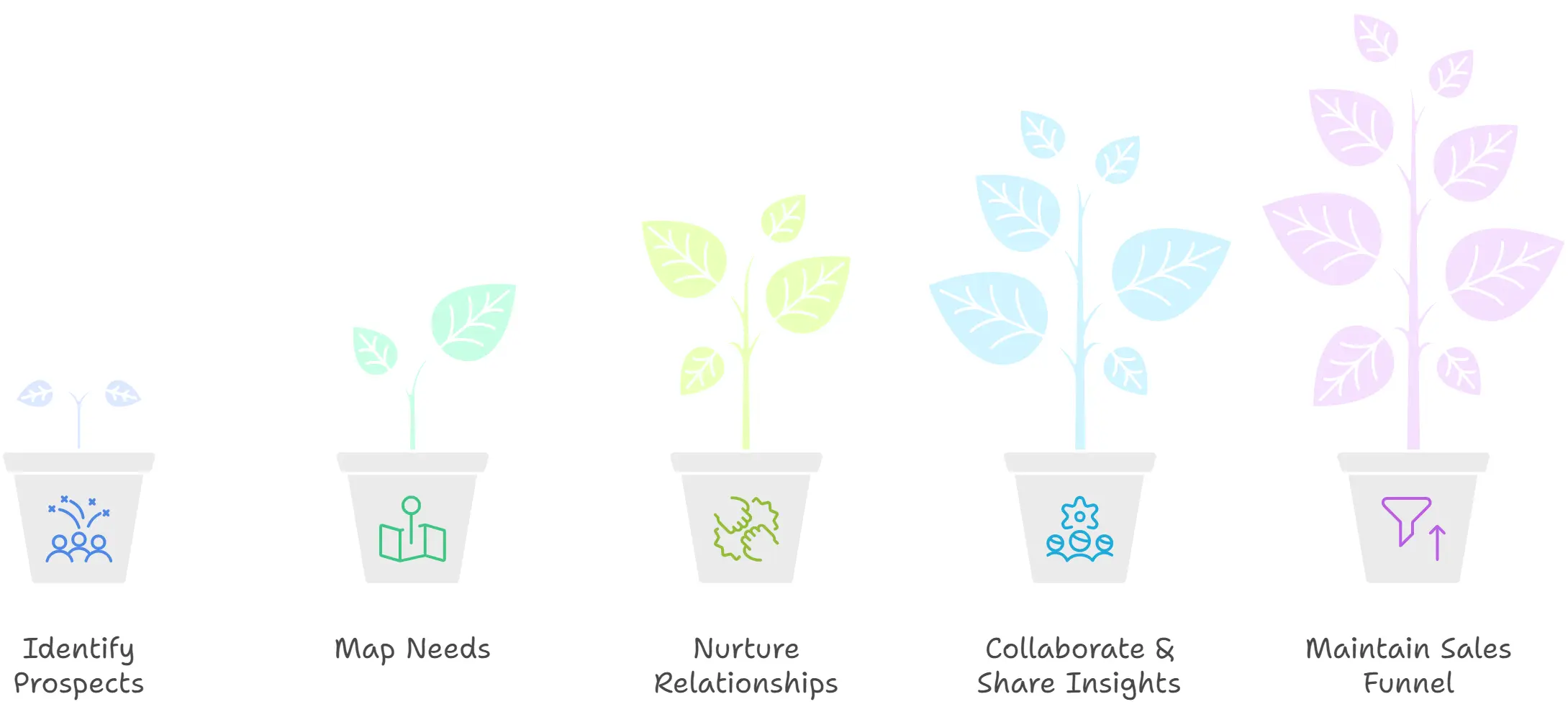
A successful sales strategy isn’t just about securing one deal; it’s about ensuring a steady flow of opportunities for the future.
That’s why building a pipeline generation plan is crucial. This means identifying target prospects early, mapping out their needs, and consistently nurturing these relationships over time.
Encourage your team to collaborate and share insights about potential leads, ensuring no opportunity slips through the cracks.
With a strong pipeline generation plan, you’ll maintain a healthy sales funnel, giving your team the capacity to focus on those big wins while simultaneously cultivating new opportunities for sustained growth.
Craft a Sales Engagement Strategy
A well-structured sales engagement strategy is the backbone of any successful team-selling effort.
It’s the roadmap that ensures everyone on the team is aligned in their messaging, approach, and value proposition at every stage of the sales cycle.
This strategy should include personalized communication tailored to the client’s unique needs, regular check-ins to maintain momentum, and a clear plan for delivering value at every touchpoint.
Having a defined strategy ensures that no step is missed and that every interaction, whether it’s a quick email, a detailed proposal, or an in-depth meeting, consistently reinforces your commitment to the client’s success.
Keep Sales Engagement High
Maintaining high levels of sales engagement throughout the process is critical to closing deals and building long-term relationships.
It’s not just about frequent communication; it’s about meaningful communication.
This could include follow-up emails that address specific client pain points, tailored presentations that showcase how your solution aligns with their goals, or even informal check-ins to show you’re genuinely invested in their success.
High engagement demonstrates your team’s dedication and keeps your client focused on the value you bring to the table.
By staying top-of-mind and delivering consistent value, you’ll build trust and position yourself as a reliable partner, not just another vendor.
Make Roles Crystal Clear
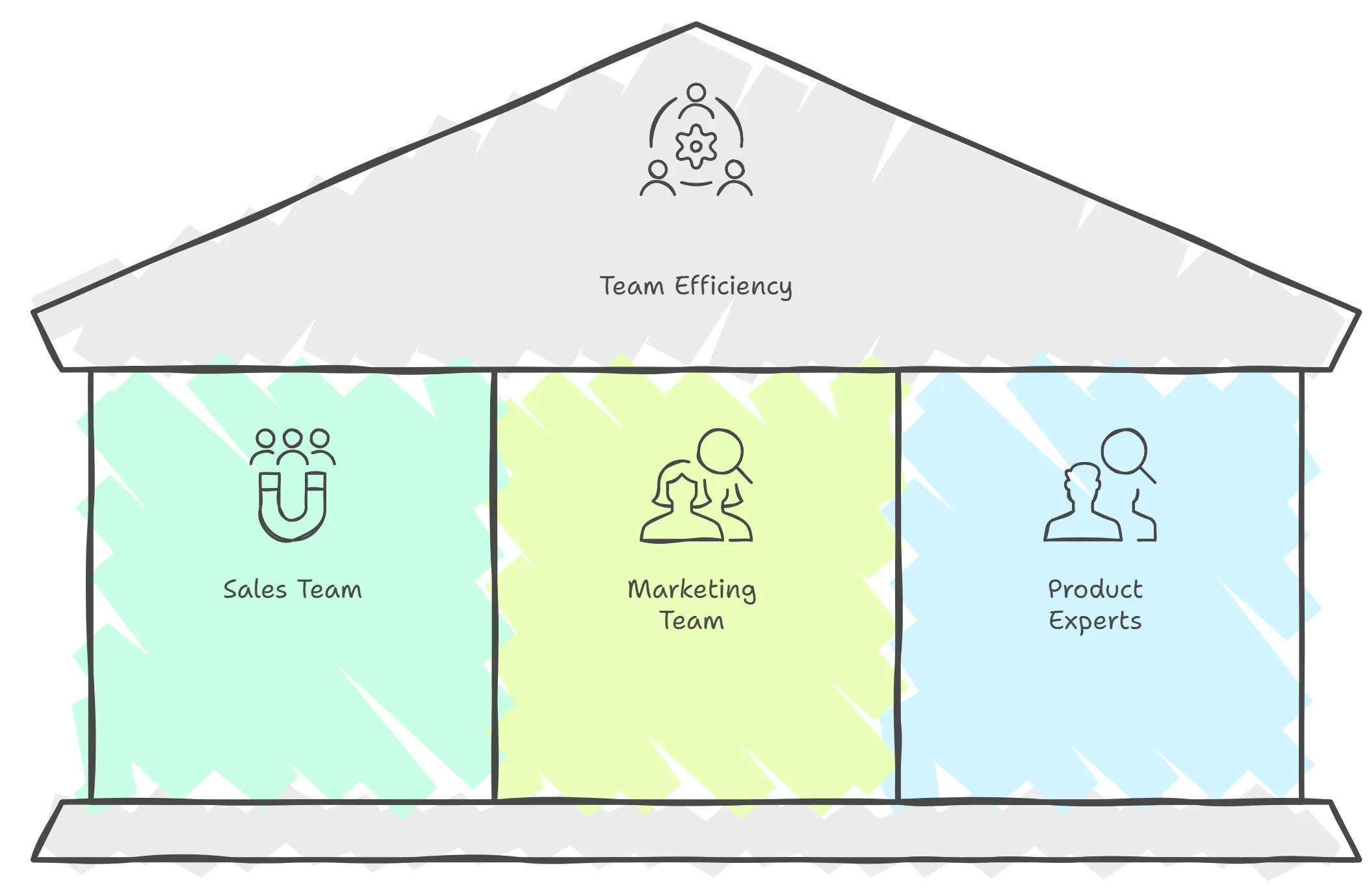
Everyone on the team should have a clear understanding of their responsibilities and contributions.
Whether it’s the sales team leading the negotiation process, marketing providing data-driven insights about the customer, or product experts stepping in to address technical questions, clearly defined roles prevent confusion and overlap.
When everyone knows their part, the team operates more efficiently, and the customer experience becomes seamless.
Play to Everyone’s Strengths
Every member of your team brings unique skills and expertise to the table—use them wisely.
Marketing professionals can use their storytelling abilities to explain how your product solves problems, engineers can dive deep into the technical aspects to build trust, and sales reps excel in relationship-building and closing deals.
By leveraging individual strengths, you create a cohesive strategy that positions your team as knowledgeable, reliable, and customer-focused.
Keep Communication Flowing
Effective teamwork relies on strong communication. Tools like Slack, CRMs, or project management software ensure everyone is on the same page and up to date on the status of the deal.
Regular check-ins, whether through meetings or quick updates, can prevent misunderstandings and help address any challenges before they escalate.
Remember, clear and consistent communication keeps your team aligned and ensures the customer feels supported throughout the process.
Always Think About the Customer
At the heart of team selling is the customer. This strategy only works if the customer feels like their needs are the priority.
Every interaction should focus on understanding their challenges, addressing their concerns, and showing them how your solution can make their life easier.
Remember, when a customer feels heard and supported, they are far more likely to trust your team and move forward with the deal.
Debrief and Tweak Regularly
After every deal, presentation, or customer interaction, take time as a team to reflect on what went well and where there’s room for improvement.
Was there a missed opportunity? Were there moments where communication or role clarity could have been better? Honest discussions and constructive feedback ensure the team continues to grow and adapt.
These debriefs will help you refine your approach, making each future interaction even stronger.
Emphasize Collaboration Over Competition
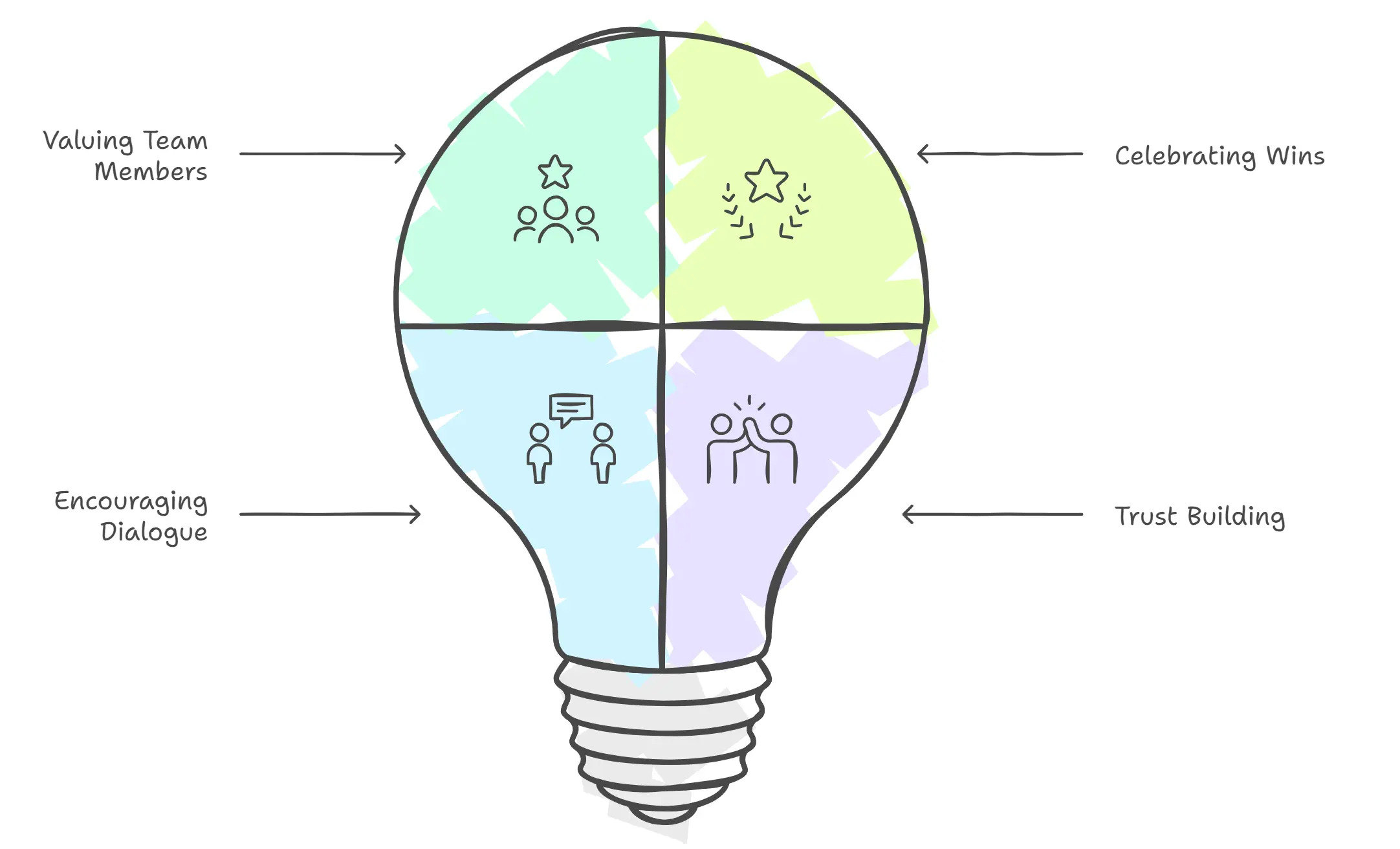
Finally, remember that team selling is about working together, not competing with one another.
When every team member feels valued and involved, it fosters a positive and productive environment.
Celebrate team wins, recognize individual contributions, and encourage open dialogue to build trust and collaboration.
When the team succeeds, everyone wins—including the customer.
When Should You Use a Team Selling Strategy?
Team selling isn’t a one-size-fits-all approach—it’s a smart strategy built for those bigger, more complex sales situations.
It’s not about piling on more people; it’s about bringing together the right group of experts to tackle the specific challenges of a deal.
We’re talking big decisions, long timelines, and lots of stakeholders. So, when does team selling really work its magic?
Let’s dive in:
Enterprise Sales
Selling to large organizations means navigating a maze of decision-makers, influencers, and gatekeepers.
You’re not just selling to one person—you’re working to gain the trust and buy-in of an entire group of stakeholders, each with their own priorities and concerns.
Bringing in a dedicated team—like product experts, customer success managers, or even your leadership—can help address specific questions, resolve concerns, and demonstrate value at every level.
This approach not only creates a deeper connection with your prospects but also helps build credibility across multiple departments.
Plus, it’s excellent for pipeline generation since you’re building relationships with key players throughout the organization, paving the way for future upsells and partnerships.
Highly Technical Products/Services
If your product or service requires a detailed explanation or involves complex features, team selling is a game-changer.
Highly technical products often need hands-on demos, in-depth trials, and expert guidance to prove their value.
Having specialists like sales engineers, solution architects, or even technical support staff on your team ensures you can handle tough questions and showcase the full potential of your offering.
These experts can break down complicated concepts, customize solutions for specific use cases, and build trust by demonstrating their deep knowledge.
This level of engagement helps prospects feel more confident, reducing hesitation and speeding up the decision-making process.
Long Sales Cycles
When deals take months—or even years—to close, it can be overwhelming for a single salesperson to manage the entire process.
Long sales cycles involve multiple touchpoints, nurturing relationships, and keeping prospects engaged over an extended period.
Team selling allows you to distribute the workload, ensuring a consistent and high-quality experience for the prospect.
For example, one team member might focus on maintaining communication and answering questions, while another takes the lead on delivering presentations or refining the proposal.
This collaborative approach not only helps prevent burnout but also ensures that prospects receive the attention and expertise they need throughout the journey.
By dividing responsibilities, you can build trust over time while maintaining momentum in your sales pipeline, ultimately increasing your chances of winning the deal.
Advantages and Disadvantages of Team Selling Approach

Advantages
Taps into diverse expertise
Team selling brings together a wider range of skills and knowledge by involving people from various departments or specialties.
This collaborative approach allows businesses to offer customers a more comprehensive and tailored solution that addresses their unique needs.
By pooling expertise, the team can provide insights and recommendations that a single salesperson might miss.
Builds stronger relationships
With multiple team members engaged in the sales process, customers are exposed to a wider network of individuals within the company.
This helps build deeper connections and fosters greater trust, as customers feel supported by a team rather than relying on just one point of contact.
These stronger relationships often translate to higher customer satisfaction and long-term loyalty.
Gets to the heart of customer needs
By involving team members from different departments—such as product development, customer support, or marketing—the sales team can better understand the customer’s pain points and requirements.
This cross-functional collaboration ensures that the solution crafted is not only comprehensive but also aligned with what the customer truly values.
It also enables the team to address potential challenges more effectively and proactively.
Drawbacks
Higher costs
Adding more people to the sales process can increase expenses significantly.
These costs might include travel, lodging, meals during meetings, or additional compensation for team members involved in the process.
For smaller companies or startups with tight budgets, the extra costs of team selling can be a barrier to adoption, making it crucial to weigh the benefits against the financial investment.
Communication hiccups
When multiple people are contributing, there’s always the potential for miscommunication.
Misaligned messaging, unclear roles, or conflicting information presented to the customer can create confusion and negatively impact the sales process.
This risk increases if the team does not have a clear communication plan or if they fail to coordinate effectively before engaging with the customer.
Harder to stay aligned
Keeping everyone on the same page is essential but challenging, especially in fast-paced or complex sales environments.
Without solid preparation, coordination, and regular check-ins, team members may inadvertently work at cross purposes or overlook critical details.
Ensuring alignment requires time, effort, and effective leadership to manage the team and maintain a unified approach.
The Two Basic Forms of Team Selling
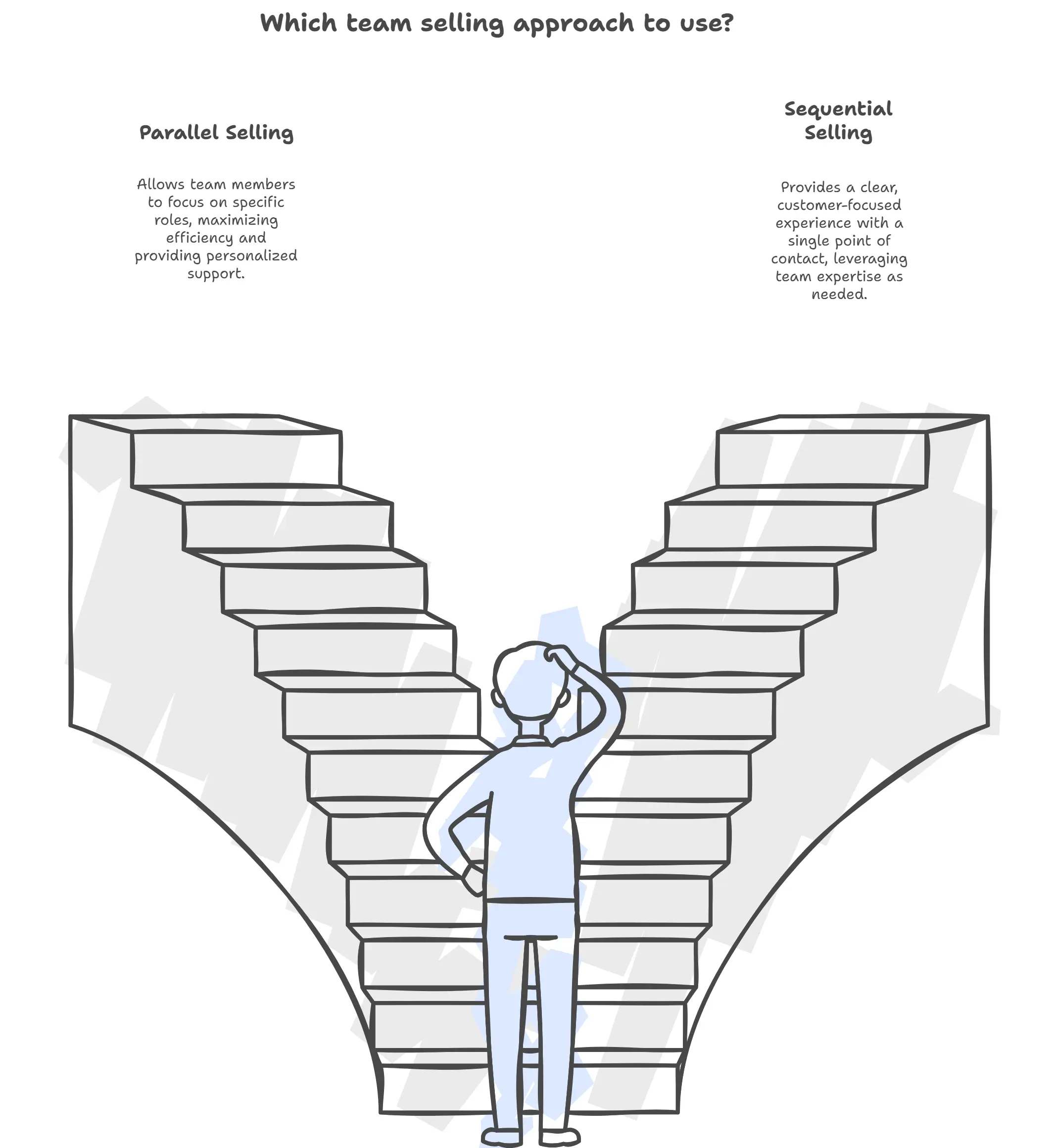
Parallel selling
Parallel selling is a team-based approach where each team member has a specific role and works directly with the customer to handle a different part of the sales process.
For example, one team member might focus on technical questions, while another handles pricing and contracts.
Behind the scenes, the team collaborates to plan and coordinate their efforts, ensuring the customer receives a seamless experience.
This method allows team members to focus on their areas of expertise while maximizing efficiency and providing personalized support at each step of the sales journey.
Sequential selling
Sequential selling is a more linear approach, where a single team member guides the customer through the entire sales process, acting as the primary point of contact.
However, this person isn’t working alone—they bring in other team members as needed to provide specialized expertise or additional support.
For instance, they might call in an engineer to address technical concerns or a manager to finalize negotiations.
This approach requires strong communication and teamwork to ensure everything runs smoothly, roles are clearly defined, and there’s no overlap or confusion in responsibilities.
It’s an effective way to provide a clear, customer-focused experience while leveraging the strengths of the entire team.
Team Selling Examples
Real Estate
Selling a property is rarely a solo effort. It usually involves a team of professionals working together to ensure a smooth transaction.
The real estate agent handles the property listing, negotiates offers, and guides the buyer or seller through the process.
The mortgage broker helps secure the best financing options for buyers, while the home inspector evaluates the property to reveal any potential issues.
A lawyer or legal advisor ensures that all contracts and documents are in order, protecting the client's interests.
Together, these experts collaborate to provide a seamless experience, ensuring the customer gets the best advice and support at every stage of the journey.
Technology Sales
Team selling is a perfect fit for the tech industry, especially when dealing with complex products or solutions that require input from multiple experts.
For instance, a sales engineer might focus on delivering detailed technical demos, showcasing how the product works and meets specific technical requirements.
Meanwhile, the account manager builds strong relationships with the client, identifies their pain points, and ensures their business challenges are fully understood.
In some cases, a product specialist or customer success manager might also be involved to address specific needs or ensure long-term satisfaction.
This collaborative approach allows the team to cater to both technical and business aspects, providing the customer with a well-rounded solution.
Consulting Services
In consulting, team selling is almost essential, particularly for handling complicated projects or addressing unique client needs.
Teams are often made up of professionals with diverse expertise—such as strategists, analysts, and industry specialists—who work together to deliver tailored solutions.
Strategists might focus on developing the overall approach, while analysts dive into the data to uncover insights.
Industry specialists bring hands-on experience and domain knowledge to the table.
This mix of perspectives and skills ensures that the client receives comprehensive advice and the best possible outcomes for their project, no matter how complex the challenge.
Team Selling vs Individual Selling
Team selling and individual selling each come with their own strengths and challenges, depending on the sales strategy and customer needs.
| Team Selling | Individual Selling |
|---|---|
| Relies on multiple team members working together | Handled by a single salesperson |
| Leverages diverse skills and knowledge | Depending on the individual’s experience |
| Provides a comprehensive solution for complex needs | Offers a more personalized, one-on-one approach |
| Requires strong coordination and planning | Simplifies communication with fewer parties |
| Can handle larger or multi-faceted deals | More suited for simpler, straightforward deals |
Yess: Streamlining Team Selling Strategy Implementation
This is where technology becomes crucial. Yess revolutionizes team selling by:
- Automatically identifying the best internal sponsors for each opportunity
- Streamlining executive involvement with one-click approvals
- Coordinating multi-person, multi-channel outreach
- Making collaboration frictionless for all team members
FAQs
Why are more companies using team selling?
More and more companies are turning to team selling to tackle complex customer needs.
It’s a great way to bring together different skills and expertise within the company, which often leads to better results.
What is the value of team selling?
Team selling has a lot of perks, like:
1. Getting a clearer picture of what customers need and how to meet those needs
2. Boosting communication and teamwork across the company
3. Tapping into different expertise to create better solutions
How can Yess help with team selling? Yess makes team selling easier by automating key tasks, improving collaboration, and simplifying communication.
It helps teams play to their strengths while working smoothly together to get the best results for customers.
Wrapping UpTeam selling is a great way for companies to tackle the growing complexity of their clients' needs.
By combining different skills and expertise, teams can create tailored solutions and deliver better results.
Tools like Yess make team selling even smoother, helping professionals focus on what they do best while working seamlessly with others.
As the business world keeps evolving, team selling will continue to be a key strategy for success in consulting.




